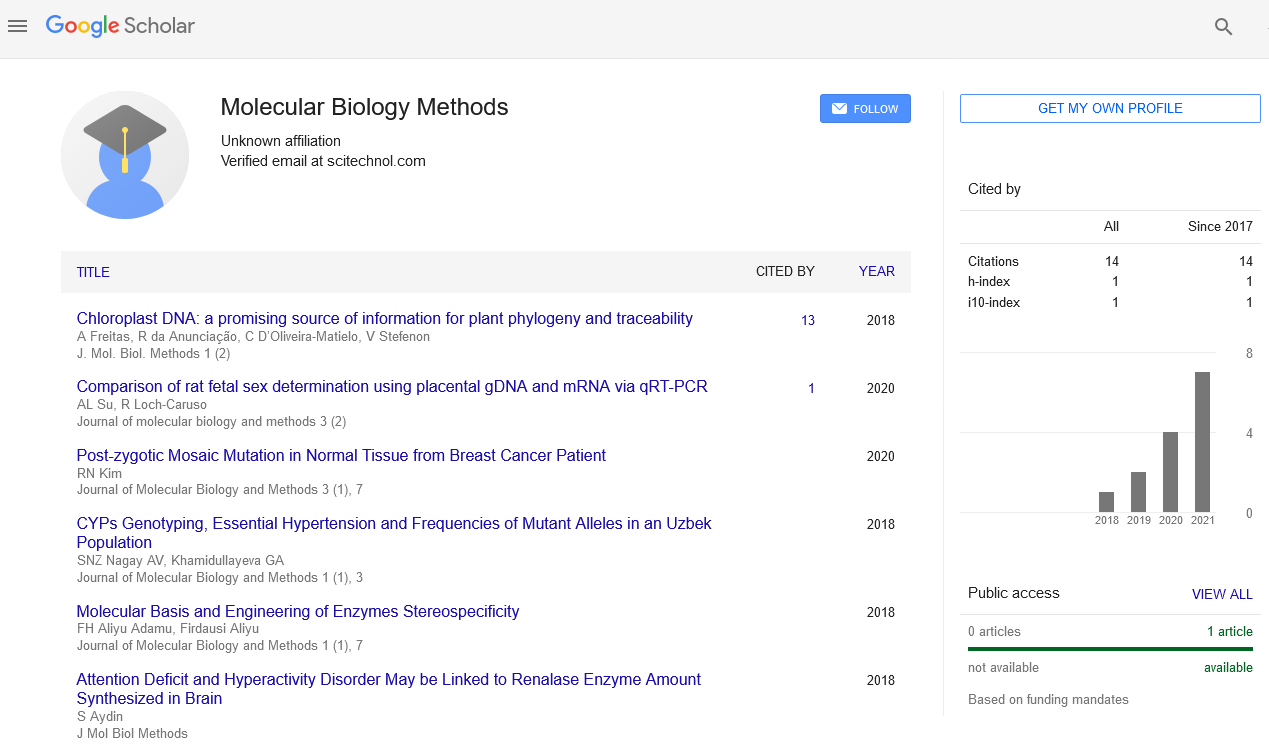Perspective, J Mol Biol Methods Vol: 4 Issue: 5
Microarrays: Types, Applications and their future
Karunakaran Kaliyappan *
Department of Oral and Maxillofacial Pathology, JKK Nataraja Dental College and Hospital, Komarapalayam, Namakkal, Tamil Nadu, India
*Corresponding author: Karunakaran Kaliyappan, Department of Oral and Maxillofacial Pathology, JKK Nataraja Dental College and Hospital, Komarapalayam, Namakkal, Tamil Nadu, India, E-mail: Kaliyappan012@gmail.com
Received date: September 07, 2021; Accepted date: September 22, 2021; Published date: September 29, 2021
Keywords: Microarrays
Introduction
Recently, peptide microarrays have been used to distinguish proteins, antibodies, viruses, and bacteria based on their binding to random sequence peptides. We reported on the use of peptide arrays to identify enzyme modulators that involve screening an array of 10,000 defined and addressable peptides on a microarray. Primary peptides were first selected to inhibit the enzyme at low μM concentrations. Then new peptides were found to only bind strongly with the enzyme– inhibitor complex, but not the native enzyme. These new peptides served as secondary inhibitors that enhanced the inhibition of the enzyme together with the primary peptides. Without the primary peptides, the secondary effect peptides had little effect on the enzyme activity. Conversely, we also selected peptides that recovered the activities of inhibited enzyme–peptide complex. The selection of cooperative peptide pairs will provide a versatile toolkit for modulating enzyme functions, which may potentially be applied to drug discovery and biocatalysis. Microarrays of 10,000 20-mer peptides were produced by Arizona State University as previously reported. Briefly, 10,000 distinct polypeptide sequences were spotted in duplicate onto a glass slide possessing an amino-silane surface coating. Each polypeptide was 20 residues in length, with 17 positions randomly chosen from a set of 19 amino acids (excluding cysteine). The C-terminal 3 positions of each peptide was a Glycine Serine Cysteine (GSC) linker, which was used for conjugating peptides to amino-silane surfaces via a maleimide linker, sulfosuccinimidyl 4-(N-maleimidomethyl) cyclohexane-1- carboxylate (Sulfo-SMCC; Pierce, Rockford, IL, USA). The array printing was performed by using a Telechem Nanoprint60 (Arrayit, Sunnyvale, CA, USA) hat spotted approximately 500 pL of 1 mg/mL peptide per feature on glass slides with 48 Telechem series SMP2- style 946 titanium pins (Arrayit). A microarray is a complex array on a solid substrate that investigates large amounts of biological material using highthroughput screening, multiplexed and parallel processing and detection methods. The antibody microarrays were the primary microarrays to be used. A journal is a periodical publication intended to further progress of science, usually by reporting new research. Most journals are highly specialized, although some of the oldest journals publish articles, reviews, editorials, short communications, letters, and scientific papers across a wide range of scientific fields. Journals contain articles that peer reviewed, in an attempt to ensure that articles meet the journal's standards of quality, and scientific validity. Each such journal article becomes part of the permanent scientific record. A microarray is a multiplex lab-on-a-chip. It is a 2D array on a solid substrate (usually a glass slide or silicon thin-film cell) that assays large amounts of biological material using high-throughput screening miniaturized, multiplexed and parallel processing and detection methods. The DNA microarray is a tool used to determine whether the DNA from a particular individual contains a mutation in genes like BRCA1 and BRCA2. The chip consists of a small glass plate encased in plastic. Some companies manufacture microarrays using methods similar to those used to make computer microchips. On the surface, each chip contains thousands of short, synthetic, singlestranded DNA sequences, which together add up to the normal gene in question, and to variants (mutations) of that gene that have been found in the human population. A DNA microarray (also commonly known as DNA chip or biochip) is a collection of microscopic DNA spots attached to a solid surface. Scientists use DNA microarrays to measure the expression levels of large numbers of genes simultane A DNA microarray is a collection of microscopic DNA spots attached to a solid surface. Scientists use DNA microarrays to measure the expression levels of large numbers of genes simultaneously or to genotype multiple regions of a genome. Each DNA spot contains picomoles of a specific DNA sequence, known as probesously or to genotype multiple regions of a genome The DNA copy that is made, called complementary DNA (cDNA), is then applied to the microarray. The cDNA binds to complementary base pairs in each of the spots on the array, a process known as hybridization. ... A black spot indicates that none of the patient's cDNA has bonded to the DNA in the gene located in that spot. SAGE can determine absolute abundance of mRNAs and differences in expression levels between samples can be compared. In contrast, microarray data is specific to the format, so data sets cannot be easily compared between platforms. Microarrays are also easier to use and more suitable for high-throughput experiments. Microarray is one of the most recent advances being used for cancer research; it provides assistance in pharmacological approach to treat various diseases including oral lesions. Microarray helps in analyzing large amount of samples which have either been recorded previously or new samples; it even helps to test the incidence of a particular marker in tumors. Till recently, microarray's usage in dentistry has been very limited, but in future, as the technology becomes affordable, there may be increase in its usage. Here, we discuss the various techniques and applications of microarray or DNA chip.
 Spanish
Spanish  Chinese
Chinese  Russian
Russian  German
German  French
French  Japanese
Japanese  Portuguese
Portuguese  Hindi
Hindi 